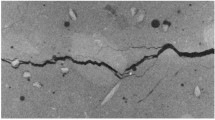Abstract
In this study, the multiple crack propagation is examined using a machine learning algorithm developed based on Voronoi tessellation method. In this way, a novel classification and geometrical dimensions-properties estimation approach, and a future-behavior-prediction method are proposed for all multiple crack formations on concrete surfaces. The crack properties, such as width, depth, length, volume, formation, etc., are measured using digital images for multiple crack formations. Then, the cracks are divided into parts to evaluate the capability of estimating the crack pattern by the use of methodology proposed in this study. Real crack formations in a construction site are observed and used in the experimental studies. The results of the experiments show that the technique developed is precise and effective for estimating multiple crack propagation on concrete surfaces. The details of the methodology developed, the crack formations observed and the estimation results obtained are presented in this paper.



















Similar content being viewed by others
References
Mohan A and Poobal S 2018 Crack detection using image processing: A critical review and analysis. Alexandria Engineering Journal. 57: 787–798
Koch C, Georgieva K, Kasireddy V, Akinci B and Fieguth P 2015 A review on computer vision based defect detection and condition assessment of concrete and asphalt civil infrastructure. Advanced Engineering Informatics. 29: 196–210
Bilir T, Gencel O and Topçu İB 2016 Prediction of restrained shrinkage crack widths of slag mortar composites by Takagi and Sugeno ANFIS models. Neural Computing and Applications. 27(8): 2523–2536
Cefis N and Comi C 2017 Chemo-mechanical modelling of the external sulfate attack in concrete. Cement and Concrete Research. 93: 57–70
Cook A C, Vel S S and Johnson S E 2018 Pervasive cracking of heterogeneous brittle materials using a multi-directional smeared crack band model. International Journal of Mechanical Sciences. 149: 459–474
Abu-Mahfouz I and Banerjee A 2017 Crack detection and identification using vibration signals and fuzzy clustering. Procedia Computer Science. 114: 266–274
Zhou M, Liao J, An L, Deng W, Hassanein M F and Yu Z 2018 Analysis of stress-induced cracks in concrete and mortar under cyclic uniaxial compression. Construction and Building Materials. 187: 652–664
Mohammed T U, Hamada H and Yamaji T 2003 Alkali-silica reaction-induced strains over concrete surface and steel bars in concrete. ACI Materials Journal. 100(2): 133–142
Karakis S, Sefercik U G, Bilir T and Atalay C 2020 Precise monitoring of temporal topographic change detection via unmanned air vehicle. Bulletin of the Mineral Research and Exploration. 161(161): 151–156
Rabah M, Elhattab A and Fayad A 2013 Automatic concrete cracks detection and mapping of terrestrial laser scan data. NRIAG Journal of Astronomy and Geophysics. 2: 250–255
Valença J, Puente I, Júlio E, González-Jorge H and Arias-Sánchez P 2017 Assessment of cracks on concrete bridges using image processing supported by laser scanning survey. Construction and Building Materials. 146: 668–678
Feng X and Murray A T 2018 Allocation using a heterogeneous space Voronoi diagram. Journal of Geographical Systems. 20: 207–226
Zhang C, Liu H and Tang Y 2019 Quantitative evaluation of voronoi graph search algorithm in UAV path planning. Proceedings of the IEEE International Conference on Software Engineering and Service Sciences, ICSESS. 8663950: 563–567
Bayar G and Bilir T 2019 A novel study for the estimation of crack propagation in concrete using machine learning algorithms. Construction and Building Materials. 215: 670–685
Li X, Krishnamurthy A, Hanniel I and Vachhani L 2019 Edge topology construction of Voronoi diagrams of spheres in non-general position. Computers & Graphics. 82: 332–342
Heath D and Kasif S 1993 The complexity of finding minimal Voronoi covers with applications to machine learning. Computational Geometry. 3: 289–305
Blakemore D M, Govender I, McBride A T and Mainza A N 2019 Multiple particle tracking in PEPT using Voronoi tessellations. Chemical Engineering Science. 207: 780–789
Nguyen M T, Maniu C S and Olaru S 2017 Optimization-based control for Multi-Agent deployment via dynamic Voronoi partition. IFAC-PapersOnLine. 50: 1828–1833
Gordon J S, Clements R A, Schoenberg F P and Schorlemmer D 2015 Voronoi residuals and other residual analyses applied to CSEP earthquake forecasts. Spatial Statics 14: 133–150
Kastrisios C and Tsoulos L 2018 Voronoi tessellation on the ellipsoidal earth for vector data. International Journal of Geographical Information Science 32(8): 1541–1557
Preparata F P and Shamos M I 1985 Computational Geometry, an Introduction. Springer-Verlag, Berlin
Author information
Authors and Affiliations
Corresponding author
Rights and permissions
About this article
Cite this article
Bayar, G., Bilir, T. Estimation of multiple crack propagation pattern in concrete using Voronoi tessellation method. Sādhanā 48, 165 (2023). https://doi.org/10.1007/s12046-023-02223-y
Received:
Revised:
Accepted:
Published:
DOI: https://doi.org/10.1007/s12046-023-02223-y




